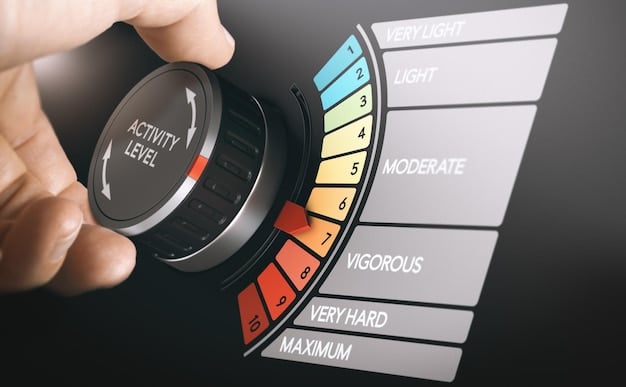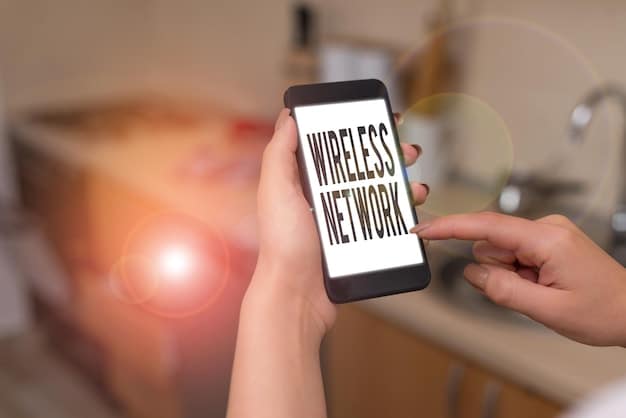Reduce Streaming Data Usage: Save Bandwidth and Money

Streaming service data usage can quickly deplete your bandwidth, leading to overage charges and slower internet speeds; however, by adjusting video quality, downloading content for offline viewing, and utilizing Wi-Fi whenever possible, you can effectively manage and reduce your data consumption.
In today’s digital age, streaming service data usage has become a significant factor in our monthly internet consumption. From binge-watching our favorite shows to enjoying high-definition movies, the data can add up quickly. Are you tired of exceeding your data limits and dealing with slow internet speeds? Let’s explore practical strategies to reduce bandwidth consumption and keep your streaming habits under control.
Understanding Streaming Service Data Consumption
Streaming services have revolutionized how we consume entertainment, but this convenience comes at the cost of data usage. Understanding the factors that influence data consumption is the first step in effectively managing it. Let’s delve into the basics of how much data different streaming activities use.
Factors Influencing Data Usage
Several factors can significantly impact how much data you use while streaming. These include video quality, streaming duration, and the type of content you’re watching.
- Video Quality: Higher resolutions like 4K consume significantly more data than standard definition (SD) or high definition (HD).
- Streaming Duration: The longer you stream, the more data you’ll use. Binge-watching can quickly deplete your data allowance.
- Content Type: Some types of content, such as live sports or action-packed movies, may use more data due to their complex visuals and audio.
Understanding these factors will help you make informed decisions about how to reduce your data consumption while still enjoying your favorite content. Adjusting these settings can lead to substantial savings on your monthly data bill.

Adjusting Video Quality to Save Bandwidth
One of the easiest and most effective ways to reduce streaming service data usage is by adjusting the video quality. Most streaming platforms allow you to choose the resolution at which you watch content. Let’s explore how this simple adjustment can impact your data consumption.
Understanding Resolution Options
Streaming services typically offer several resolution options, ranging from low-quality standard definition (SD) to ultra-high-definition 4K. Each resolution consumes a different amount of data per hour.
- Standard Definition (SD): Uses around 0.7GB per hour.
- High Definition (HD): Uses around 3GB per hour.
- Ultra High Definition (4K): Uses around 7GB per hour.
By lowering the resolution, you can significantly reduce your data usage. For example, switching from 4K to HD can save you up to 4GB of data per hour. Consider whether the improved resolution is worth the extra data consumption.
Downloading Content for Offline Viewing
Another excellent way to reduce your streaming data consumption is by downloading content for offline viewing. Many streaming services offer the option to download movies and TV shows directly to your device. This allows you to watch content without using any mobile data.
Benefits of Offline Viewing
Downloading content for offline viewing not only reduces your data usage but also provides other benefits such as:
- Conserving Data: By downloading content over Wi-Fi, you avoid using your mobile data allowance while watching.
- Watching on the Go: You can enjoy your favorite shows and movies while traveling, commuting, or in areas with poor internet connectivity.
- Avoiding Buffering: Offline viewing eliminates the risk of buffering issues, providing a seamless viewing experience.
Make use of the offline viewing feature to maximize your data savings. Remember to download content while connected to Wi-Fi to avoid using your mobile data.
Utilizing Wi-Fi Whenever Possible
Using Wi-Fi whenever possible is a straightforward yet highly effective strategy for minimizing streaming service data usage. Wi-Fi connections typically don’t count towards your monthly mobile data allowance, allowing you to stream content without worrying about exceeding your data limits.
Maximizing Wi-Fi Usage
Here are some tips to help you make the most of Wi-Fi connections:
- Home Wi-Fi: Connect all your streaming devices to your home Wi-Fi network to avoid using mobile data while at home.
- Public Wi-Fi: Take advantage of public Wi-Fi hotspots at coffee shops, libraries, and other public places. However, be cautious when using public Wi-Fi, as it may not be secure.
- Mobile Hotspots: If you have a mobile hotspot, use it to connect your streaming devices when Wi-Fi is not available. Be mindful of the data limits on your mobile hotspot plan.
By prioritizing Wi-Fi connections, you can significantly reduce your reliance on mobile data and keep your streaming service data usage under control.

Monitoring and Tracking Your Data Usage
Keeping track of your data usage is essential for staying within your monthly data limits. Most devices and streaming services offer tools to monitor your data consumption. By regularly checking your data usage, you can identify trends and make informed decisions about your streaming habits.
Tools for Monitoring Data Usage
Here are some tools and methods you can use to monitor your data usage:
- Device Settings: Most smartphones and tablets have built-in data usage trackers in the settings menu. These trackers show how much data each app is using, allowing you to identify data-hungry streaming services.
- Streaming Service Apps: Some streaming service apps also provide data usage statistics. Check the app settings to see how much data you’ve used during a specific period.
- Internet Service Provider (ISP): Your ISP typically provides a data usage tracker on their website or app. This tool allows you to monitor your overall data consumption for the month.
By actively monitoring your data usage, you can identify areas where you can reduce consumption and avoid exceeding your monthly data limits. This proactive approach will help you stay in control of your streaming data.
Choosing Data-Efficient Streaming Services
When it comes to streaming services, some are more data-efficient than others. Understanding the data usage characteristics of different platforms can help you make informed choices that align with your bandwidth limits. Let’s explore how to identify and choose data-efficient streaming services.
Comparing Data Usage Across Platforms
Different streaming services use varying amounts of data for similar content. Here’s a general comparison:
- Netflix: Offers various data-saving options; can use around 1GB per hour in standard definition.
- YouTube: Data usage varies widely based on video quality. Lowering the resolution can significantly reduce data consumption.
- Amazon Prime Video: Offers similar data-saving features as Netflix. Adjusting video quality can help manage data usage effectively.
By researching and comparing the data usage of different streaming services, you can opt for platforms that align with your bandwidth limits. This can lead to significant data savings over time.
| Key Point | Brief Description |
|---|---|
| 📉 Adjust Video Quality | Lower resolution to save data; HD uses less than 4K. |
| ⬇️ Offline Downloads | Download content on Wi-Fi to watch without using mobile data. |
| 📶 Use Wi-Fi | Connect to Wi-Fi at home and public hotspots whenever possible. |
| 📊 Monitor Data Use | Track data usage on devices, apps, and ISP to control overages. |
Frequently Asked Questions
▼
Streaming in 4K can use up to 7GB of data per hour. Adjusting the streaming quality settings can reduce this consumption significantly.
▼
Yes, Netflix allows you to download many of its movies and TV shows for offline viewing. Make sure to download over a Wi-Fi connection.
▼
On your iPhone, go to Settings > Cellular > Cellular Data Usage to see how much data you’ve used in the current period.
▼
Services that offer adaptive bitrate streaming and efficient compression algorithms, like Netflix and YouTube, can use less data when optimized.
▼
While convenient, public Wi-Fi can be risky. Use a VPN to protect your data. Avoid entering sensitive information like passwords on unsecured networks.
Conclusion
Managing streaming service data usage is easily achievable by implementing several strategies. From adjusting video quality and downloading content for offline viewing to utilizing Wi-Fi and monitoring data consumption, these tips can help you enjoy your favorite content without exceeding your bandwidth limits or incurring extra costs.





